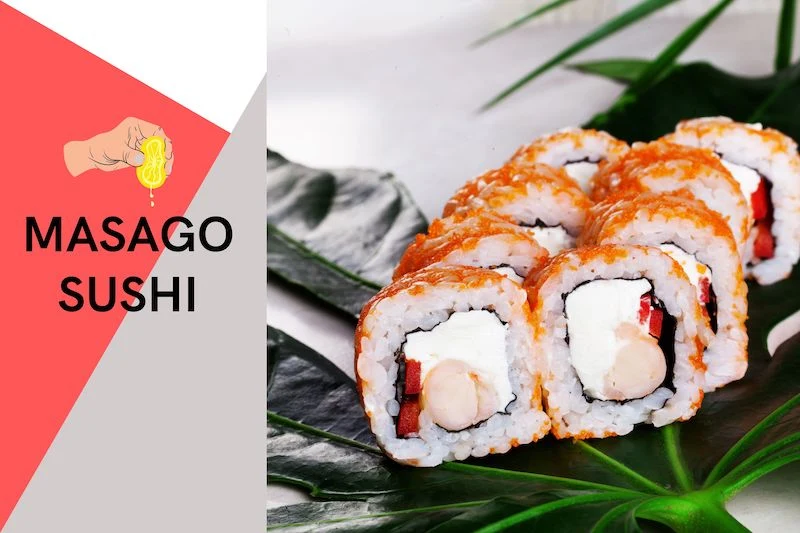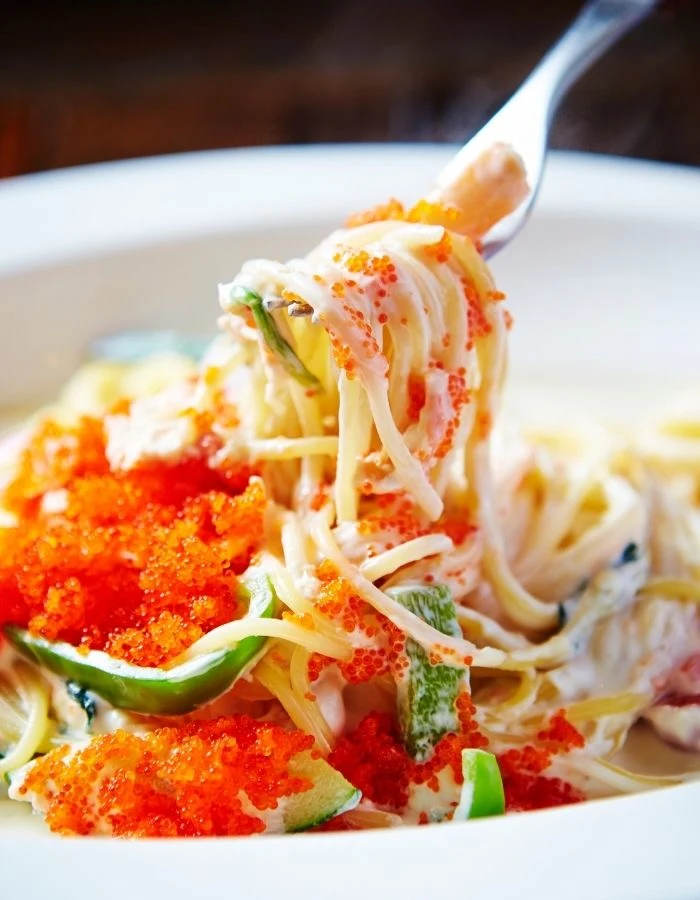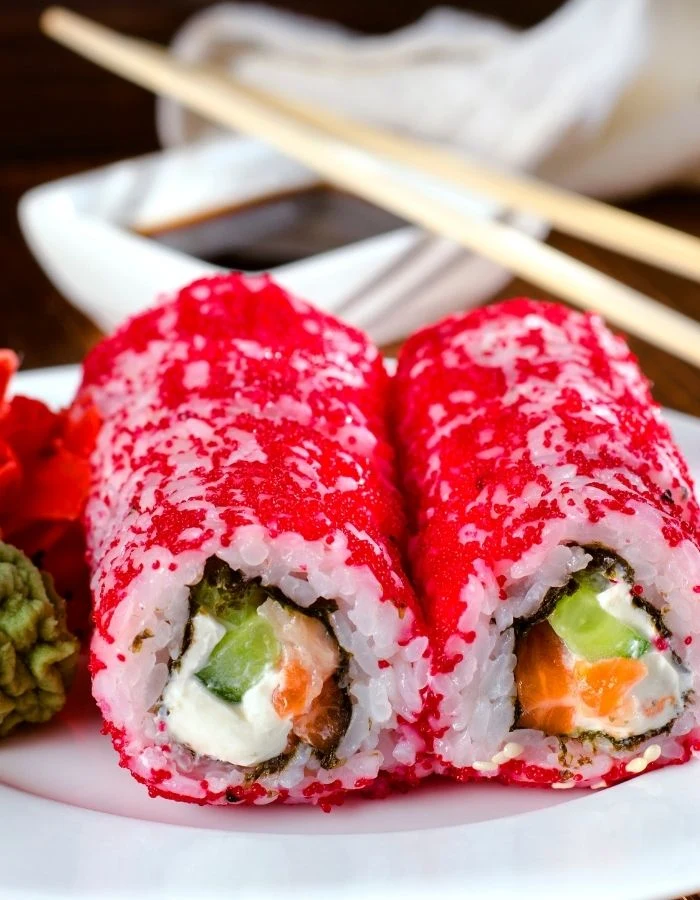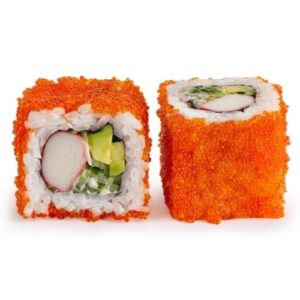
Masago, well known as ikura in Japanese, is a kind of fish roe that comes from capelin. The Capelin roe can be taken from female fish that are between two and four years old when they begin producing eggs. The roe is removed just before the fish reaches full maturity. Though capelin fish are edible, many people do not bother using them as a source of meat because of their tiny size. Instead, they are sought after for other items such as Masago, fish oil, and fishmeal.
What is Masago Sushi?
Masago sushi is a product that results when Masago and Suchi are combined together. Capelin roe is popular in many places because it is more accessible and less expensive than other fish roe varieties. Ikura, uni, Masago, and Tobiko are just a few of the popular kinds of fish roe on sushi. Beluga sturgeon caviar is another type that comes from this species.
What is the Difference Between Masago vs Tobiko?
Although Masago and Tobiko appear to be similar, there are a few differences between them that include:
- Color: The flesh of Tobiko is golden, whereas Masago has a more pale-yellow color. However, manufacturers use various colors to flavor and dye the components.
- Fish species: Masago and Tobiko are made from two different kinds of fish species. Tobiko is made from flying fish roe, and Masago is made from roe smelt.
- Price: Masago is usually less expensive than Tobiko. Tobiko and Masago may be found in most Asian food stores.
- Size: Tobikos are considerably bigger than masagos.
- Texture: The texture of Masago is soft, while the texture of Tobiko is quite crunchy.
Masago Sushi Nutrition Value
Masago, despite being consumed in little quantities, provides a significant nutritional profile and may enhance your intake of several important minerals, including selenium, vitamin B12, and magnesium. It is a nutrient-dense food since it has a high concentration of important vitamins and minerals. Masago brings the following nutritional values:
1. Natural Source of Vitamin D
Vitamin D is a nutrient that humans require in order to maintain healthy bones. It’s also one of the few natural sources of vitamin D, an essential micronutrient that many people don’t get enough of. In fact, vitamin D deficiency symptoms include tiredness, sadness, sleeplessness.
2. High-Quality Protein
Masago contains a high amount of quality protein. A little portion weighing about 28 grams can provide 6 grams of protein. This is the same as the amount of protein in a big egg with a weight of around 50 grams. (1) Adding Masago to your diet can help you consume less while still being satisfied. As a result, the body will be satisfied, and weight will be lost.
3. Selenium and Vitamin B-12
Selenium is abundant in Masago. As a result, it’s an excellent antioxidant for your body. Selenium is present in fish in high concentrations. As a result, it can aid in the treatment of hypothyroidism and immunological disorders. (2)
Food rich in Masago has been shown in several studies to help boost the immune system and prevent mental deterioration. Vitamin B-12 is abundant in masago. Vitamin B-12 promotes energy production and nerve health. (3)
4. High in Omega-3
Masago contains a high quantity of omega-3 fatty acids, which are heart-healthy fats that have been shown to promote a variety of benefits. Omega-3 fatty acids can not only assist in maintaining cardiac health, but they may also help protect cognitive health, reduce inflammation, and aid in weight management. (4, 5)
5. Low in Mercury
It’s also low in mercury and can be eaten safely during pregnancy, according to the American Pregnancy Association. Masago may be consumed safely by pregnant women in moderation with other low-mercury seafood options like salmon and Tobiko, according to the American Pregnancy Association. (6)
Learn More: What Is Cold Pressed Juice, And Benefits Of Drinking Cold Pressed Juice
How To Store Masago?
Masago should be frozen before it is stored to maintain its flavor. If it is kept correctly, it can be used for up to half a year. If defrosted and re-frozen, it should be eaten within four days and kept at cold temperatures in the fridge.
What To Serve With Masago?

Masago is a Japanese fish egg that has been eaten by many civilizations because of its high nutritional value. It is most frequently seen outside the sushi rolls. The egg sacs of Masago are typically pale yellow. However, they may be colored more brightly to make the dish appear to resemble more costly types of fish roe.
They are also used in side dishes and sauces for extra crunch. Masago can also be used to make a creamy and delectable sauce that is frequently served over spaghetti noodles. Additionally, Masago can also be used as a sushi topping, although it is sometimes put in the fillings of maki rolls to provide extra taste and texture.
Masago Sushi Health Benefits
Masago’s high nutrient content makes it beneficial to one’s weight, heart, stress, and immune system. Below are some of the health benefits of using Masago:
1. Heart Health
Omega-3 acids are vital in maintaining heart health, according to the research published on Omega-3 Acids. Furthermore, fish roe has a shallow omega-6 acid content, which further promotes cardiovascular health.
2. Immune System
Selenium mineral is sometimes neglected, yet it is present in high amounts in Masago. It can aid the operation and reactivity of your immune system, according to the investigation published on Immunology.
3. Weight Gain
It is one of the most nutritious foods in existence, containing more than half of your daily requirement for all essential vitamins and minerals. It’s also a great source of energy for the body because it’s high in protein. According to research published in the American Journal for Clinical Nutrition, sashimi is excellent for managing weight gain since protein.
4. Metabolism
Vitamin B-12 is extremely abundant in Masago, which may help to manage the metabolism by maintaining proper levels of energy.
5. Cognition
Masago has also been linked to a decreased risk of cognitive deterioration and neurodegenerative diseases, such as Alzheimer’s and Parkinson’s disease, according to research.
6. Fatigue and Depression
Vitamin D deficiency is common in people living in regions where there is little sunshine. Depression, sleeplessness, and tiredness are just a few of the symptoms. Masago is a vitamin D-rich meal for the people who need it!
Masago Sushi Side Effects
Let’s look at the possible adverse effects of the Masago in detail below:
1. Allergy
Masago has no harmful effects on its own, but fish roe allergens are somewhat prevalent, and Masago contains a protein that is an allergy trigger. Other dermal allergic responses have been documented as well.
2. Sodium
The high sodium content of Masago, which is associated with elevated negative health consequences and blood pressure when consumed in excessive amounts, makes it a poor choice. Furthermore, because this fish roe is frequently added to foods that are already salty, be careful with your intake.
3. Unhealthy Ingredients
Many Masago makers and producers add undesirable additives, such as corn syrup AND other chemicals that reduce the product’s nutritional value. When you’re buying Masago in quantity, stick to reliable farms or dealers only.
Read More: What are The Benefits of Ginger Lemon Shots?
How To Make Masago Sushi?

Is it worth investing in a high-quality Masago Sushi Roll, which includes rice or the topping of Masago sushi and seaweed? This sort of dish is simple to prepare, as shown in the steps below:
- Cuisine: Japanese
- Course: Snack, Lunch
- Cooking Time: 1 hour
- Servings: (3 Rolls)24 pieces
- Calories: 65kcal
Ingredients
For Sushi Rice
- 1 cup sushi of short-grain sushi rice.
- 1 tablespoon of optional sushi vinegar.
- 1 cup water
- 1/2 teaspoon salt
- 1/2 tablespoon sugar
For Masago Sushi
- 4 oz imitation crab
- 1 tablespoon masago
- 2 sheets nori seaweed
- 1 avocado cut thin slices
Instructions
- Begin by filling your rice cooker with water and rinsing the rice.
- Place the cooked rice in a large mixing dish, then add sugar, sushi vinegar, and salt.
- To begin, lay down the bamboo mat with a piece of plastic wrap paper on top.
- Using a pair of scissors, cut each nori sheet in half.
- On top of the bamboo, place half of the nori sheet.
- Take a cup of cooked rice and cover the nori equally with it. Gently press it down with your hands.
- Reduce the heat to low. Turn down the heat so that rice is facedown and nori faceup.
- Add the avocado and crab to the nori.
- Tuck the thumbs beneath the bamboo mat and raise the edge up.
- Apply some pressure to tighten the mat up.
- Place the roll on a cutting board and cut it into ten pieces.
- Place a tiny bit of Masago on each sushi piece. You can manually distribute it as desired.
Low-Calorie Recipe: Low Fat Low Sodium Alfredo Sauce Recipe Capelin eggs are a delicacy in various parts of the world, including Japan and Europe. The edible fish eggs of the smelt roe or Masago. They have high protein and antioxidants, plus they have omega-3s, selenium, and vitamin B12. Remember that roe products with extra ingredients such as salt, MSG, or high fructose corn syrup should be avoided, but if you can tolerate seafood and want a unique flavor component for your recipes, try Masago. We include products, that’s are useful for our readers. If you buy through links on this page, we may earn a small commission.
Bottom line

Masago Sushi
Ingredients
For Sushi Rice
For Masago Sushi
Instructions
Nutrition
